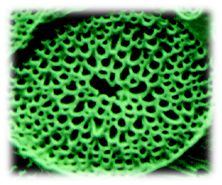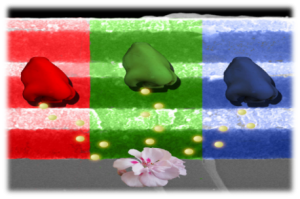Past Scientific Contributions
In what follows a compendium of significant materials chemistry and nanochemistry contributions from our research group will be briefly described.
- Naked metal clusters – “atom-by-atom” synthesis of controlled nuclearity, ligand-free metal clusters enabled the first insight into the fuzzy interface between molecular nanoclusters and quantum size nanocrystals.
- Chemistry of naked metal clusters – “atom-by-molecule” synthesis provided the first insight into cluster-surface relations involving molecules binding to bare metal atoms and clusters compared to molecules chemisorbed on metal surfaces.
- Nanoporous materials – first to transition the half-century old field of zeolite science from traditional catalysis and gas separation into the new world of nanoporous materials through nanochemistry, trendsetting research that enabled a plethora of advanced nanoporous materials technologies.

- Biomimetic materials chemistry – transferred Nature’s best materials ideas into the advanced materials and nanomaterials chemistry laboratory – first to found the field of morphosynthesis that focuses on growth and form of organic template inorganic materials with “natural form”.
- Hybrid nanomaterials chemistry – first to invent a new class of nanocomposites called periodic mesoporous organosilicas (PMOs), with properties that transcend the sum of inorganic and organic components, finding widespread interest in microelectronic packaging, catalysis, dental implants and drug delivery.

- Host-guest inclusion chemistry – amongst the first to synthesis of size, shape and surface controlled semiconductor and metallic nanomaterials nucleated, grown and stabilized within the spatial confines of nanoporous hosts – inspired research on colloidal nanocrystals.
- Mesoscopic materials chemistry – first to demonstrate the growth and form of self-assembled materials with structural features between nanoscopic and macroscopic scales, exemplified by spheres, wires, rods, helices, films and lithographic patterns that underpin many of today’s nanotechnologies.
- Photonic crystal materials chemistry – chemistry approach to the world’s first silicon photonic crystal with a complete photonic bandgap at optical telecom wavelengths, research that enabled for the first time actively tuned photonic color devices being commercialized by www.Opalux.com.

- Nanolocomotion – co-founded the first demonstration of futuristic and rapidly expanding field of autonomous nanomotors and purposeful nanomachines whose power is obtained from on-board catalytic reactions of energy-rich fuels.
Recent Scientific Accomplishments
Over the past decade our research group has been exploring new and exciting synthetic pathways to novel classes of nanomaterials, exemplified by nanocrystals and nanowires, nanoporous materials and nanophotonic crystals. These nanomaterials are considered to be of interest to a wide range of fundamental studies in nanoscience ultimately of relevance to the field of nanotechnology.
In synopsis form, a selection of some of the more significant contributions that have emerged from our group’s research during the past five years and that have benefited from the scientific input of national and international collaborators in chemistry and physics, materials science and engineering, biology and medicine include the following:
- Synthesis, structure, property, function and utility of ‘green’ nanomaterials based on carbon, silicon, germanium and bismuth sulfide
- Understanding the chemistry of nanocrystal nucleation and growth
- Development of methods for nanocrystal size separation
- Measurement of size dependent nanocrystal properties
- Visible wavelength silicon nanocrystal light emitting diodes
- Molecular nanocluster – quantum size effect nanocrystal transition
- Tumor imaging using photoluminescent silicon nanocrystals
- Ultrathin nanowires that look, grow and behave like polymers
- Selectively transparent and conducting nanoporous Bragg mirrors
- Slow photon photovoltaics, photocatalysis and photochemistry
- Novel electrodes for high efficiency dye sensitized solar cells
- Synthesis and chemistry of periodic mesoporous organosililca and hydrido silica materials
- Vapor phase templating of periodic mesoporous silica and organosilica films
- Low-k periodic mesoporous organosilica films with air walls
- Nanoporous Bragg mirrors for electrochromics, lasers, organic light emitting diodes, sensors and antibacterials
- Photonic crystal full color display, security devices and color sensors for food and water quality control and pathogen detection
Ideas to Innovation
 Using an innovative chemical-synthesis approach we have developed periodic light-scale materials with the unique ability to control photons in the same way that semiconductors control electrons. The key characteristic of these active photonic crystals is their ability to electrically, mechanically, and chemically tune color from structure. This revolutionary concept, coupled with the unique properties of the photonic crystals, forms the basis of photonic color technology, a breakthrough currently finding significant application and impact in a range of novel devices. In this context, Opalux Incorporated (www.Opalux.com), a Toronto-based spin-off company that emerged from our research group and founded to expressly to develop, manufacture, and commercialize photonic color technology, has readied three unique manifestations of the technology for the market:
Using an innovative chemical-synthesis approach we have developed periodic light-scale materials with the unique ability to control photons in the same way that semiconductors control electrons. The key characteristic of these active photonic crystals is their ability to electrically, mechanically, and chemically tune color from structure. This revolutionary concept, coupled with the unique properties of the photonic crystals, forms the basis of photonic color technology, a breakthrough currently finding significant application and impact in a range of novel devices. In this context, Opalux Incorporated (www.Opalux.com), a Toronto-based spin-off company that emerged from our research group and founded to expressly to develop, manufacture, and commercialize photonic color technology, has readied three unique manifestations of the technology for the market:
- P-Ink is a fully flexible, electronic paper-like material offering a full spectrum of electrically-tunable, reflective colors – extremely power-efficient it is one of three competitive technologies vying to add color to black-and-white electronic book readers such as Kindle and Kobo.
- P-Nose is an artificial nose comprised of a simple, cost-effective pixilated array of surface-functionalized nanoporous materials that enable discrimination of different analytes, exemplified by molecules comprising the unique identifiers of different bacteria. Think of the possibilities for medical diagnostics, and food and water quality-control.
- Elast-Ink is a touch-sensitive material that responds to mechanical pressure while offering exceptional resolution and customizability. It is poised to answer global demand for effective authentication-technology – serving, for example, the pharmaceutical and banknote-printing industries.
